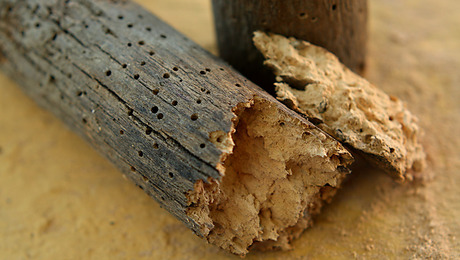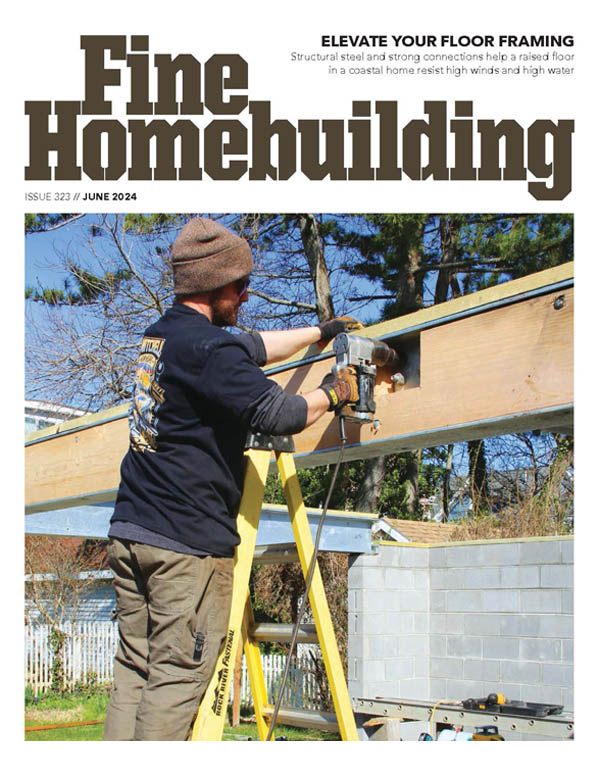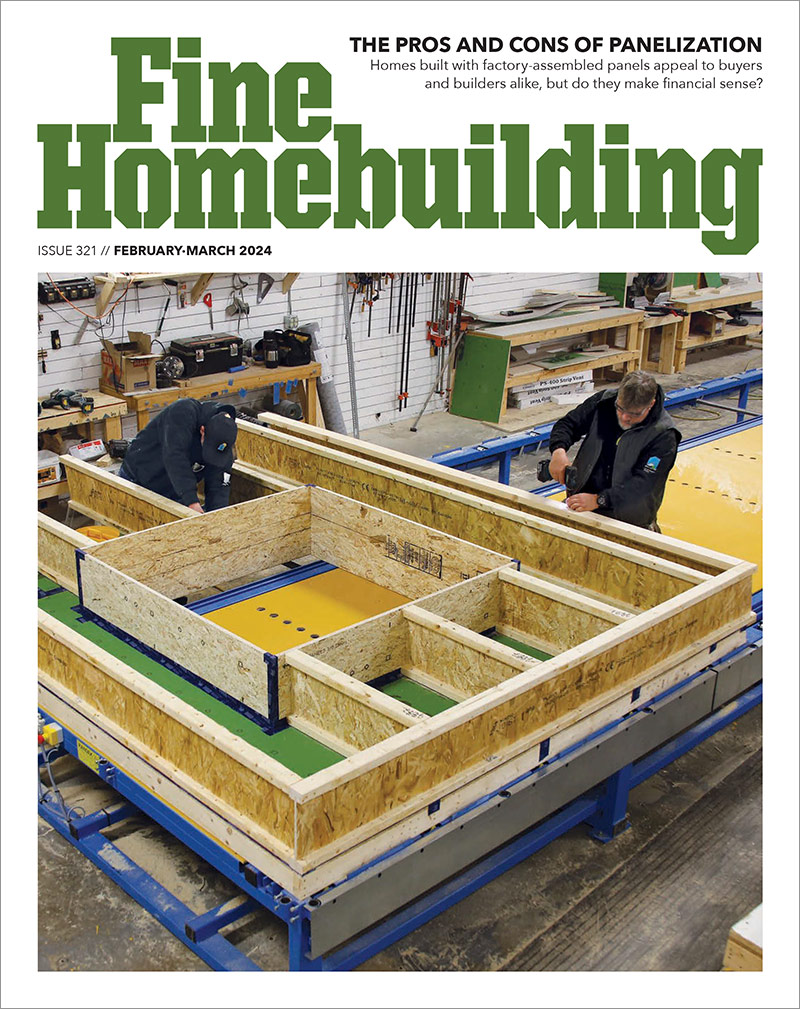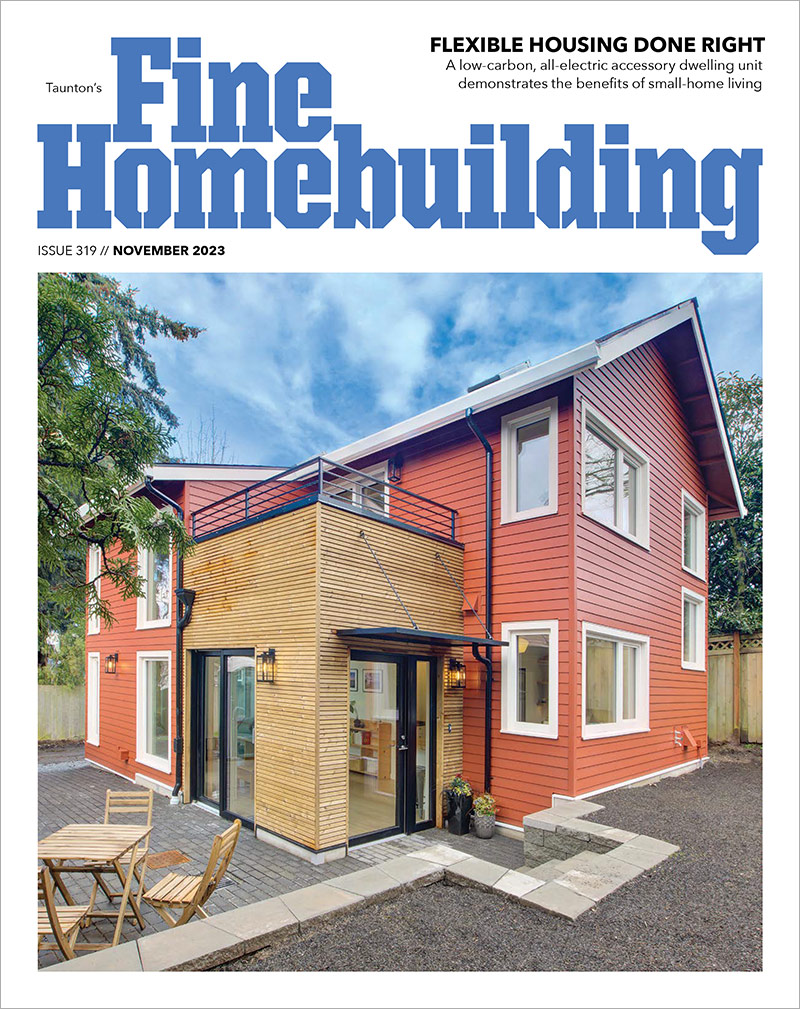What determines subpanel breaker size?
Feed from house to garage for subpanel. 40 feet of SE cable runs from the house panel thru the crawl space to the foundation, and 65 feet of direct burial 2-2-4 runs from the house foundation to the garage panel, so the total run is 105 feet of wire. I have not physically looked at the SE cable but I assume it is the gauge equivalent of the 2-2-4.
My electrician installed a 100A breaker in the main panel. Before we started the job I discussed it briefly with the inspector and he said we *might* have to use a 90A breaker.
What is/are the governing factor(s) in determining the breaker size? It’s all done and the inspection is this week, but I’m not sure if the breaker will fly. Obviously the electrician thinks it’s the right one.


















Replies
The breaker is to protect the wire from overheating/burning. The longer the wire, the lower the breaker size. A rated 100 amp box doesn't mean a 100 amp breaker. You could run UP TO any wire capable of 100 amps over its run.
Troy Sprout
Square, Level & Plumb Renovations
Is this aluminum or copper wire? Based on the wire gauge I'm guessing it's aluminum. #2 aluminum wire can be used in residential applications for loads up to 100 amps, so I think you should be okay (this is from table 310.15(B)(6) in the 2005 NEC book, if the inspector asks.) I don't do residential electrical electrical design so this is a little out of my area of expertise - hopefully 4Lorn1 or one of the other guys will weigh in on this to confirm if I'm right.
Also, for a distance of 105 feet, #2 aluminum carrying 240vac at 100 amps has an acceptable amount of voltage drop, so you're okay from that standpoint.
David,
There are many table in the National Electrical Code that list the ampacity of different conductors in various situations. Ampacity is just electrician code-speak for how much current a wire can carry without heating up so much that it begins to self-destruct--usually by melting the insulation off.
The table that applies to branch circuit and to feeder conductors is Table 310.16 (all references I give are to the 2002 Code, which is the operative one in my area). A feeder is a conductor between two overcurrent protection devices (like circuit breakers). It's what runs from the main panel to a subpanel.
The table gives the current-carrying capacities of wires of different materials (copper or aluminum) of different gages and insulations, at a given ambient temperature, for three or fewer current-carrying conductors, when the conductors are in cable, raceway (conduit), or directly buried in the earth. These things all affect how much juice a wire can carry safely.
You have to adjust the ampacity value if there are more than three conductors carrying current (i.e., you don't count the equipment grounding conductor for ampacity determinations), and correct the ampacity value if the ambient temp is higher than the baseline temp (which is 86F). These adjustment and correction factors are given in the same part of the Code (Article 310).
The electrician's uncertainly might arise from the fact that it takes a careful read to decide which table applies. A real common mistake when sizing feeders is to mis-apply another ampacity table.
Specifically, there is a table that lists ampacities for conductors between the utility company connection and the electric (revenue) meter, or the meter and the main panel. These are called, respectively, the service entrance conductors and the main power feeders, and are allowed to be a gage smaller than a branch circuit conductor or a feeder, because it's not likely that the SE conductors or main power feeder will have to carry the entire current available at the service, or at least not for very long. Most heavy loads in a house, like the AC, electric range, spa heater, etc, cycle on and off once they reach the temp set point.
The SE conductor/main power feeder amapcity table is Table 310.15(B)(6). It is for "...feeder conductors that serve as the main power feeder to a dwelling unit..." [text at (310.15(B)(6)]. Italics are mine; those are the words that are often ignored.
Because the text for table 310.15 includes the word "feeder", many electricians incorrectly use (and inspectors allow it to be used) to size feeders other than SE conductors/main power feeders. I guess that they figure a subpanel isn't likely to draw all the current that the feeder breaker can provide. Mis-applying the table allows them to use conductors that are a little smaller than they should be. That means less cost and a little easier time installing them.
But it's a violation of Code. The NEC Handbook, the official guide to interpreting the NEC, is very clear on the issue.
Is it a "real" hazard if the feeders are one gae smaller than they ought to be? It depends--if the total demand of the loads supplied by the subpanel is at or over the ampacity of the feeder breaker and conductors, you'll be relying on the feeder breaker to protect the feeder from overload.
If that feeder breaker ever fails to operate, it could be a catastrophic failure--cable overheats, insulation melts, short circuit, big heat and arc, until the main breaker trips. Even if there's no breaker failure, the conductors could be subjected to more heating more often (because they're undersized). Theat may lead to eventual failure.
Good luck,
Cliff
"The SE conductor/main power feeder ampacity table is Table 310.15(B)(6). It is for "...feeder conductors that serve as the main power feeder to a dwelling unit..." [text at (310.15(B)(6)]. Italics are mine; those are the words that are often ignored."You're right, and I stand corrected. The referenced table only covers service entrances and main power feeders. It is a little misleading if one doesn't read the text, since the table just says 'feeders' which infers more than just the main power feeder.Anyway, now that I read it again, the text indicates it doesn't apply to branch circuit feeders. This would mean the circuit in question is probably limited to 90 amps. In the end, though, it will come down to what the local inspector says.
I'm not a pro, so I'm sure you are right, but here is why I have always thought 310-15(b)(6) also applies to sub-panels: The first sentence of the paragraph says the table applies in 3 situations: 1)service entrance conductors, 2)service lateral conductors, and 3)feeder conductors that serve as the main power feeder to a dwelling unit. Now, if the text stopped there, I would agree with you. But the very next sentence is, "For application of this section, the main power feeder shall be the feeder(s) between the main disconnect and the lighting and appliance branch circuit panelboard(s)...." (By the way, that sentence was ADDED starting with the 99 Code, so clearly they meant it as a clarification of their use of the word 'feeder').
Since "lighting and appliance branch circuit panelboards" are what we all call sub-panels, I think they are explicitly saying 310-15(b)(6) applies. If not, how can you explain their including wording about "lighting and appliance branch circuit panelboard(s)" ?
Of course, I'm quoting from the 99 NEC, so if it has changed that would explain our disagreement.
R--
No change in the 2002 Code.
The words "between the main disconnect and the branch circuit lighting and appliance panelboards" are the key.
A feeder between a "branch circuit lighting and appliance panelboard" and another "branch circuit lighting and appliance panelboard", i.e., between a feeder breaker in the main panel and the subpanel does not fit the description of a main power feeder, at least not in my book.
From 310.15(B)(6): "For application of this section, the main power feeder shall be the feeder(s) between the main disconnect and the lighting and appliance branch circuit panelboard(s)."
Why use the plural (feeder(s)... panelboard(s))? Because in some cases, power may run from the meter to more than one main panel--for example, a 320 or 400 amp service where there are two main power feeders, each one feeding a 200 amp panel. So there are two main power feeders. Or in the case where the main power feeder runs from the meter (or main cutoff) to the main panel, then from feed-through lugs of the main panel to another main panel. That feeder would be part ofthe main power feeder IMHO and could be sized per 310.15.
Construing the use of the plural "panelboards" to mean the main panel and a subpanel, and therefore the feeders to include the main power feeder and the subpanel feeder, is not what was intended, at least from what I understand. The main power feeder or SE condictors can be downsized a gage because of load diversity for a house. Not so for a subpanel--like a kitchen subpanel, where most of the loads cold be on at once. O'course, it all depends on how well the subpanel was sized.
Anyway, as I see it, once the main power feeder gets to a panelboard, it physically stops--the wire is interrupted, terminated on the panel hot bus lugs (or on the panels MB lugs), and it's no longer the main power feeder. A feeder that's protected by a breaker in the main panelboard and runs to another panelboard (i.e. subpanel) is just a feeder, and falls under 310.16.
Ain't the NEC great? In spite of all the effort that goes into writing it as clearly as possible, it's still as clear as mud sometimes.
Best,
Cliff
Edited 10/24/2005 7:17 pm ET by CAP
I'll keep re-reading it and trying to understand.
I will take issue with you for sure on one thing though: you said "Ain't the NEC great? In spite of all the effort that goes into writing it as clearly as possible..." I'm cynical enough to believe it's just the opposite: Can it be that NO ONE on the code-making panels can write unambiguous English ? They have 3 years to come up with straightforward declarative sentences. Their garbled syntax is for a purpose: It's for the Stallcup's, Shapiro's, and Mike Holt's of the world to say: "Oh, you don't understand it ? Well, here, buy my book, buy my videos. Or better yet, I have a 3 day seminar coming up and for only $1100...."
If they wrote clearly they would be out of a job.
Re:"Can it be that NO ONE on the code-making panels can write unambiguous English ? They have 3 years to come up with straightforward declarative sentences. Their garbled syntax is for a purpose"...Yes, it is for a purpose.2005 NEC:
Article 90.1 Purpose(A) Practical safeguarding.
"The purpose of this Code is the practical safeguarding of persons and property from hazards arising from the use of electricity."(B) Adequacy
"This Code contains provisions that are considered necessary for safety. Compliance therewith and proper maintenance results in an installation that is essentially free from hazards." ...(C): Intention
"This Code is not intended as a design specification or an instruction manual for untrained persons."The NEC is not a DIY manual and isn't intended to be. The concepts, order, hierarchy and language are very exactingly used and defined to convey the information. Taking any particular article or section out of context and without proper training and understanding often leads to errors. It has to be taken as a whole. Most, if not all, of the phraseology that many untrained people have the most problems with are worded the way they are because they keyhole, refer to and interact with other sections of the NEC or with other NFPA publications.As for the particular question at hand: This subject has been flogged to death. Anyone not capable of finding, reading and understanding this information, on this forum and others, really needs to call an electrician.Electrical work is, at first glance, pretty simple but, on the face of it, so is brain surgery. Let's see you need a knife, got one of those, and a drill for that skull bone ...
"This subject has been flogged to death. Anyone not capable of finding, reading and understanding this information, on this forum and others,"
OK, I took your advice and went to the ECN discussion forum (Electrical Contractor Network - all pros there). A search on 310-15 got a ton of discussion. Here's one comment from the MODERATOR of the forum:
The (s) as in "feeder(s)and panelboard(s)" was added in the '99 Code. In '96 it was "feeder, panelboard".This would certainly lead me to believe that the reduced conductor sizes would apply to multiple feeders.There is no such thing as a "subpanel" in the eyes of the NEC, and the conductors are feeders until the final branch circuit OCPD...S
I think you are representing the answer to the question as a lot more cut and dried than it is.
So exactly how it that not "cut and dried".Look closely at the moderators response. All he is saying is that there are minor changes at each iteration of the code. When you actually do the real world math most don't change things much. The differences between editions are not your concern. This is an esoteric discussion for those following the Code. All this amounts to is saying that the Code is a living, man made document representing the best current thinking on the subject. Even though it is often referred to as 'the electricians bible' it didn't come down fully formed from on high. The Code is complicated because it is trying to adequately cover every possible situation and contingency while keeping up with advances in materials, fire science, engineering, electrical and building, and even current fashion. The use of blow driers in the 70s caused more changes to house wiring and the electrical grids than most understand. Because it necessarily needs to be complicated it has to be taught and learned. A process and struggle which can further bolster the resemblance to the Bible by bringing a grown man to his knees until they capture the logic and structure of the Code. But none of this is a real concern in this case.Simply put what is germane to this case is finding out which Code year the concerned AHJ is operating from, not a few jurisdictions are a cycle or two behind, and complying with that edition while taking into account any local understandings and accepted practices. What changes have happened before or after that edition is not a major consideration.
Others have already bandied about the NEC tables re: conductor size / length of run / etc.
No one has mentioned your description of the SE cable - 2-2-4.
Around Delaware this cable would have to be SER ( R=round) 2-2-2-4 assuming aluminum.
Our local authority considers a sub-panel to be nothing but an overgrown wall box, which requires 2 full sized "hot", 1 - full sized neutral, and a full or down sized ground conductor. The hots and neutral are isolated from contact with the sub-panel and the ground is connected to the panel via a ground bar.
Breakers are connected in the sub-panel via the hot busses, neutrals only connect to the neutral bars, and grounds go only to the ground bar.
Do you drive a ground rod at the sub-panel? How do you get by using the #4 as the neutral?
Jim
Never underestimate the value of a sharp pencil or good light.
2-2-4 is the generic term around here for AL direct burial wire used to feed a garage or shop. There were four conductors installed from panel to panel (2 hot, one neutral, one ground in blk/grn insulation), and a #4 stranded copper ground wire from the subpanel to (2) ground rods driven in the ditch.
My electrician did the work, but he's not a man of many words and an explanation of this stuff is not forthcoming from him. I did question the 90A vs. 100A breaker, and he did some checking and agreed that the inspector was probably going to require the 90A. I only had an inkling about that because I talked to the inspector separately on another job.
Oh, well, I guess I did do some of the work--I operated the sledge hammer for driving the ground rods. The first 7 feet were easy, then they hit bedrock. The inspector permitted them to be bent over into the ditch just below grade.
Got it on the cable size / configuration.
Suffice it to say the 90A breaker has to do with the length of run and a few other factors. For your purposes the difference between a 90 and a 100 is zero, zip, nadda.
Jim
Never underestimate the value of a sharp pencil or good light.